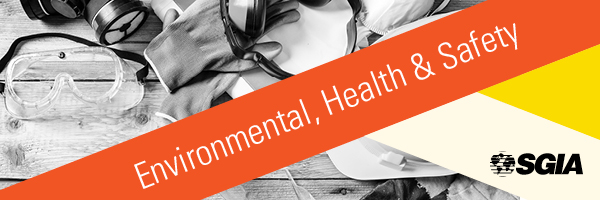Every year, the Occupational Safety and Health Administration (OSHA) announces the most frequently cited workplace violations for the year. OSHA’s newest top 10 violations span the 2018 fiscal year (October 1, 2017–September 30, 2018).
OSHA’s list includes violations from several industry segments including construction and general industry, with printing falling under the latter. In order to provide more definitive direction for printing operations, the top 10 violations for printing were isolated from OSHA’s violation statistics.

The list below represents the top 10 violations for the printing industry:
- Hazard communication (29 CFR 1910.1200) OSHA’s Hazard Communication Standard (HCS) requires information be communicated to employees about the chemical hazards they are exposed to and protective measures to ensure their health and safety. Common citations include not having a written program, safety data sheets for all chemicals, employee training and secondary container labels.
- Lockout/tag-out (29 CFR 1910.147) The lockout/tag-out regulation protects employees from unexpected machine startups or hazardous releases during servicing and maintenance. Failing to lockout equipment, have a written program and conduct annual inspections of machine-specific procedures are the most common violations.
- Machine guarding (29 CFR 1910.212) OSHA has several standards to protect employees from exposure to hazards such as ingoing nip points, point of operation, flying sparks and chips, and other moving components. This regulation requires that physical guards be provided to protect employees from exposure and contact to the hazards associated with moving parts.
- Respiratory protection (29 CFR 1910.134) If respirators, other than dust masks, are to be provided to employees, there are very specific steps that must be followed. Failing to establish a written respiratory program was one of last year’s most common violations, followed by the failure to provide proper medical evaluations to those using respirators.
- Powered industrial trucks (29 CFR 1910.178) Employees that operate forklifts or other industrial-powered vehicles such as pallet jacks must be initially trained, certified and reevaluated every three years. Safety violations include improper vehicle use, lack of training and failing to re-certify operators every three years.
- Personal protective equipment (29 CFR 1910.132) OSHA requires all employers to conduct a formal written workplace hazard assessment to determine what personal protective equipment is required to protect employees from injuries. In addition, employers are required to provide the personal protective equipment and provide employee training on its proper use. Failure to conduct the assessment and certify it is a commonly overlooked requirement.
- Electrical safety (29 CFR 1910.305) This is one of several OSHA regulations addressing electrical safety and includes access to breaker boxes, breaker identification and guarding. Common violations under this standard involve blocked access to breaker boxes, open breakers, missing knockouts in junction or breaker boxes, and no or incomplete labeling of breakers.
- Machine guarding (29 CFR 1910.219) OSHA has several standards protecting employees from exposure to hazards from power transmission components found on equipment including pulleys, flywheels and drive shaft. Failure to provide a physical guard to prevent employee contact with these moving machine parts is a common violation.
- Electrical safety (29 CFR 1910.303) This regulation addresses methods, components and equipment. Common violations under this standard involve the use of extension cords, power strips, improper pendant drops and frayed wiring.
- Portable fire extinguishers (29 CFR 1910.157) There are very specific requirements for the placement, mounting, access and maintenance of portable fire extinguishers. Common violations include blocking access to fire extinguishers, not having them checked annually and not providing annual training for employees expected to use them.
Hazard communication violations continue to be the most common in printing operations. Due to the continued focus on the printing industry as a high hazard industry for amputations, the violations for not meeting the requirements for lockout/tag-out and machine guarding remain in the top 10 list. Given the serious nature of these violations, the average penalty remains high in the $7,000–$10,000 range for each violation. Electrical safety violations are also very common and are easily addressed given that the average penalty range is $3,000–$5,000.
When conducting an inspection, OSHA tends to find multiple violations, and the citations can be very costly. Even though OSHA can reduce penalties for small businesses, many citations for printing operations will start with a total penalty range of $35,000–$40,000. The penalties can be much higher for larger operations.
How to utilize this top 10 list depends upon your current safety program status. If you are just implementing a program, use it as a way to focus your efforts, or use it to check for any potential improvements for your currently established program. There are many OSHA regulations and addressing the top 10 will allow you to efficiently use your resources.
For more resources to help strengthen your Safety Program, visit
SGIA's Safety & Health Section